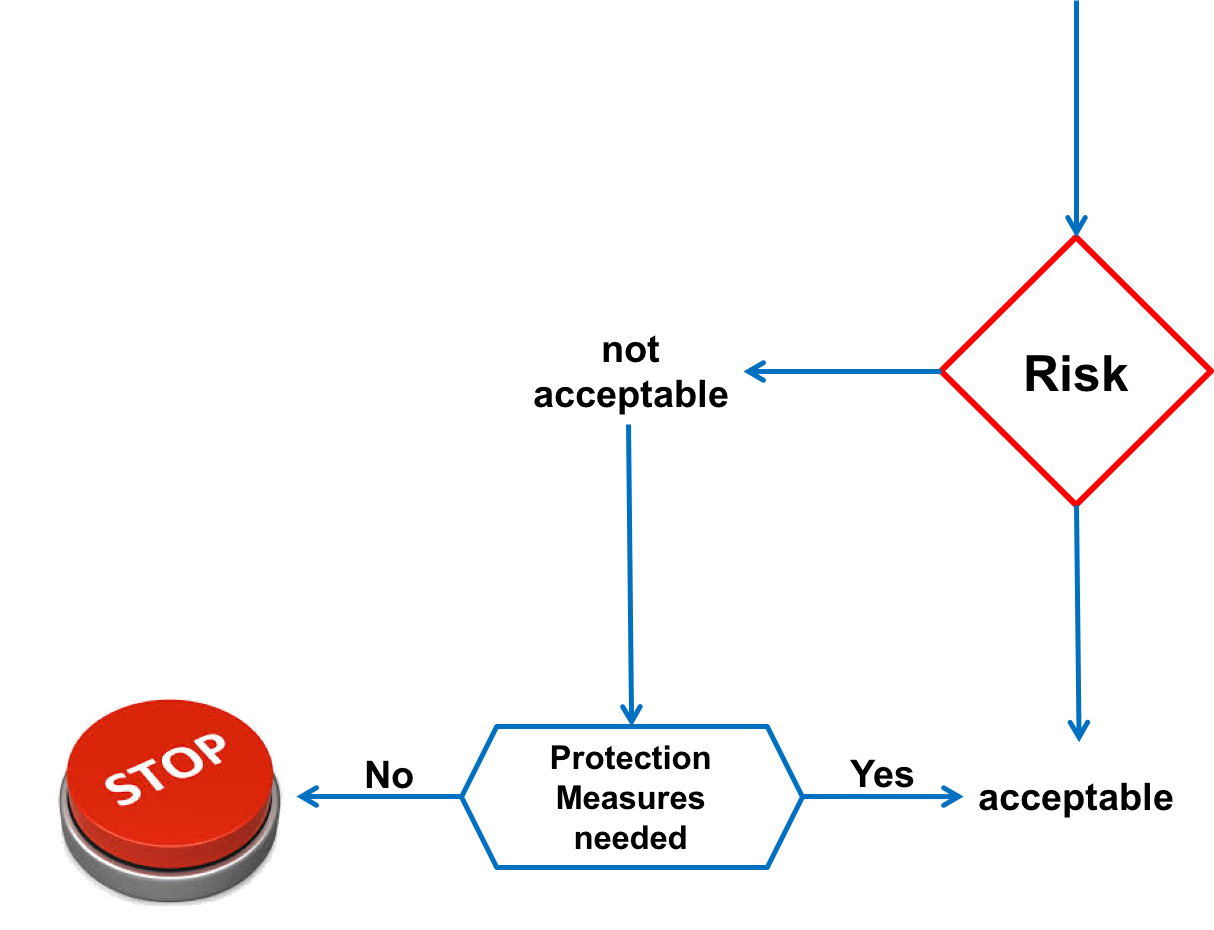The definition of a level of acceptable risk of new nanomaterials is defined on a societal consensus and political decision based on scientific risk assessment. The measures to reduce or prevent risks are part of adapted or new laws and regulations which stand at the end of a sophisticated process called risk management. During the process and at the very end the measures have to be disseminated and explained properly.

Decision-making process © DaNa-team.
Risk management of nanomaterials is an integral part of risk analysis and is directly based on risk assessment. For nanomaterials, usually a chemical risk assessment is chosen. After a thorough risk assessment it will arrive at a point where a decision must be taken. In Europe, the decision whether the assessed risk of a nanomaterial is seen to be inacceptable, acceptable under certain safety precautions or completely acceptable, is based on National or European legislation. In fact this has been done by bringing into force the European chemical legislation REACH in 2007. It controls the production and use of chemical substances, and their potential impacts on both human health and the environment. This regulation also includes nanomaterials. It is managed and administrated by the European Chemicals Agency (ECHA).
Last, the measures to reduce risks connected with nanomaterials are divided into informational, technical or personal safety equipment measures. These measures to reduce or prevent risks then become part of new, or adapted, laws and regulations.
Activities and Methods for Risk Management of Nanomaterials
In Germany, several public and insurance organizations are involved in risk analysis and risk assessment of nanomaterials with specific foci on workplaces (e.g. BAuA, DGUV), consumers (e.g. BfR) and the environment (e.g. UBA). The basis of their work is often linked to risk assessment within REACH, which represents the fundamental pillar of European legislation. Although nanomaterials are not explicitly mentioned in REACH, some other pieces of European legislation do mention nanomaterials. For instance, the biocide legislation requests specific safety testing of nanomaterials. Food legislation defines nanomaterials and demands the identification of new nanomaterials used as additives in food.
Based in the UK, the Institute of Occupational Medicine (IOM), an independent centre in the fields of occupational and environmental health, hygiene and safety is involved in risk analysis and risk assessment of nanomaterials. Together with support from the UK Government, IOM has established a free information resource called SAFENANO. It provides industry with services in toxicology, exposure and risk assessment of nanomaterials. In the USA, the National Institute of Health (NIH) together with the National Toxicology Program (NTP) are involved in risk analysis and risk assessment of nanomaterials.
With the given limitations of risk assessment, alternative decision-support methods and approaches are being explored heavily on an international base e.g. the Nano Risk Framework developed by US-based Environmental Defense Fund (EDF) and DuPont Corporation, the risk governance framework developed by the Swiss International Risk Governance Council (IRGC) as well as NanoRiskCat [1] developed by DTU Environment.
A qualitative or semi-quantitative risk assessment and management approach to promote occupational health and safety at the workplace in small businesses is control banding. It is a method, which is used to guide the assessment and management of workplace risks by providing a straight forward and practical approach to avoid or control hazardous exposures at work.
In practice, risk management at the workplace for instance results in different measures, sometimes related to the production machine or process (special housing, closed system, air exhaust) sometimes regarding the workers (breathing mask, gloves, helmet etc.). In any case the target is to reduce the exposure down below the threshold limits of the hazardous material. The same is true for consumers. In case of a possible risk, there has to be a respective labelling of the product (e.g. ethanol as flammable, pesticides as toxic etc.) and the consumer has to handle it with care.
Risk Communication
 Once a risk of a new (nano) material is scientifically identified, it is important to transfer or “translate” the information to the decision making parties and to the public. This needs to be done in a responsible way that no misleading information is spread. This can be provided through a process called “risk communication”. It is a sophisticated interdisciplinary process to publicly bring up and discuss an issue in the light of basic values of a specific public. One major goal is to improve collective and individual decision making. Our project DaNa is one way to do risk communication to various stakeholders of our society by presenting the data on various nanomaterials with all their possible effects on humans or in the environment.
Once a risk of a new (nano) material is scientifically identified, it is important to transfer or “translate” the information to the decision making parties and to the public. This needs to be done in a responsible way that no misleading information is spread. This can be provided through a process called “risk communication”. It is a sophisticated interdisciplinary process to publicly bring up and discuss an issue in the light of basic values of a specific public. One major goal is to improve collective and individual decision making. Our project DaNa is one way to do risk communication to various stakeholders of our society by presenting the data on various nanomaterials with all their possible effects on humans or in the environment.
Literature
- Hansen, S.F. and Baun, A. (2011): NanoRiskCat – A Conceptual Decision Support Tool for Nanomaterials. Danish Ministry of the Environment (PDF, 1.8 MB )
 >
>